Assessing and Prioritizing the Climate Change Policy Objectives for Sustainable Development in Pakistan
Abstract
1. Introduction
2. Climate Change Policy Objectives with Special Reference to Pakistan’s Economy
2.1. Climate Change Policy Objective Criteria (CCPOC) and Climate Change Policy Objective Sub-Criteria (CCPOSC) Policy in Pakistan
2.2. Climate Change Policy Objectives (Alternatives) in Pakistan
2.2.1. Institutional Capacity Building (CCPOA1)
2.2.2. Water Security (CCPOA2)
2.2.3. Integration of National Policies (CCPOA3)
2.2.4. Natural Disaster Management (CCPOA4)
2.2.5. Natural Resource Management (CCPOA5)
2.2.6. Social Sector Development and Health (CCPOA6)
2.2.7. Environmental Financial Structure (CCPOA7)
3. Methodological Framework for Climate Change Policy Objective Prioritization
3.1. Fuzzy AHP
- Step I:
- Construct the hierarchical structure of the problem.
- Step II:
- The pairs of criteria, Equation (1), sub-criteria, Equation (2), and alternatives, Equation (3) are evaluated and compared:where for every , (), and .where criterion () comprises the criteria, andwhere N is the number of alternatives related to each K criteria; .
- Step III:
- The weights of three matrices in Step 2 are determined gradually, using the extent analysis, fuzzy arithmetic [75], and the extension principle. All resulting weights are normalized as:where .where ; .In Equation (6), ‘’ represents the sub-criteria weights with the total length “K”.
- Step IV:
- In this step, the aggregation principal is applied to reduce the two hierarchy tiers (i.e., criteria and sub-criteria) to a single tier:where is set of the m criteria, with its sub-criteria; is the number of sub-criteria of the j-th criterion.
- Step V:
- This step comprises an estimation of the fuzzy decision matrix and fuzzy performance matrix. The fuzzy decision matrix is obtained from the estimations of the fuzzy extent analysis in Step 3 for the alternatives as:The fuzzy performance matrix indicates the overall performance of each alternative related to all sub-criteria:
- Step VI:
- The ultimate values of the alternatives are obtained in the form of triangular fuzzy numbers:
- Step VII:
- The last step is defuzzification: the alternative with the greatest weight is deemed to be the optimal one. The sum of the weights of all the alternatives equals zero:
3.2. Fuzzy VIKOR
- Step I:
- Construct the fuzzy performance matrix and the weight vector as:In Equation (1),alternatives i, ;criterion or attribute j,fuzzy performance rating of alternatives (A’s) with respect to criterion (c’s);= the fuzzy weight for each criterion. Here, can be defined as and as a TFN.
- Step II:
- The ideal and the nadir values of each criterion function according to the benefit or cost functions were determined. The set of criteria expressing benefits (good or positive effects) is symbolized as , and a set of criteria expressing costs (unfavorable or negative effects) is symbolized as .
- Step III:
- The normalized fuzzy differences () were estimated.
- Step IV:
- The values and were estimated:
- Step V:
- The next step is to estimate the values :In the above equation, and . Additionally, is a weight for the strategy of “the majority” criteria (), and is the weight of the individual regret (.
- Step VI:
- Defuzzify , , and .
- Step VII:
- The next step is to rank the alternatives, sorting them by their crisp values in descending order. The results would be in three ranking lists, , and , according to , , and , respectively.
- Step VIII:
- Suggest a compromise solution for the alternative —the optimal solution by the measure if the following conditions hold:C1. “Optimal benefit”:where is the advantage rate alternative (ranked first), compared with the alternative in the second position, in and .C2: The acceptable stability of the decision-making is determined as an alternative, and the must also be the best ranked by S or R.If one of the above conditions is not fulfilled, a set of compromise solutions (CS) is suggested which consists of:CS1: The alternative and if only C2 is not satisfied.CS2: The alternatives , …, if condition C1 is not satisfied: is determined by the relation for the maximum M (the position of these alternatives in closeness).
3.3. Proposed Approach to the Problem
4. Results and Discussion
4.1. Results of the Fuzzy AHP Analysis of the Climate Change Policy Objective Criteria (CCPOC (Criteria))
4.2. Results of the Fuzzy AHP Analysis of Climate Change Policy Objectives Sub-Criteria (CCPOSC)
4.2.1. Ranking of the Sub-Criteria (CCPOSC1i’s) with Respect to the Energy Criteria (CCPOC1)
4.2.2. Ranking of the Sub-Criteria (CCPOS2i’s) with Respect to the Transport Criteria (CCPOC2)
4.2.3. Ranking of the Sub-Criteria (CCPOSC3i’s) with Respect to the Urban Planning Criteria (CCPOC3)
4.2.4. Ranking of the Sub-Criteria (CCPOSC4i’s) with Respect to the Industry Criteria (CCPOC4)
4.2.5. Ranking of the Sub-Criteria (CCPOSC5i’s) with Respect to the Agriculture Sector Criteria (CCPOC5)
4.3. Results of the Fuzzy AHP Analysis of OVERALL CCPOSC with Respect to the Goal
4.4. Results of the Fuzzy VIKOR for Climate Change Policy Objective (Alternatives)
5. Conclusion and Policy Implications
Author Contributions
Funding
Acknowledgments
Conflicts of Interest
Appendix A
| Serial # | Designation | Gender | Qualification | Age | Organization |
|---|---|---|---|---|---|
| 1. | Professor | Male | Ph. D. | 54 | Arid Agriculture University Rawalpindi |
| 2. | Professor | Male | Ph. D. | 53 | University of Agriculture Faisalabad |
| 3. | Chief Economist | Male | Ph. D. | 57 | Planning Commission of Pakistan |
| 4. | Additional Secretary | Male | Master | 45 | Ministry of Climate Change, Pakistan |
| 5. | Director General (Environment) | Male | Master | 49 | Ministry of Climate Change, Pakistan |
| 6. | Deputy Secretary | Female | Master | 42 | Ministry of Climate Change, Pakistan |
| 7. | Director (Monitoring, Lab & Implementation) | Male | M. Phil. | 41 | Environmental Protection Department, Punjab, Pakistan |
| 8. | Director (Environmental Impact Assessment) | Male | Master | 44 | Environmental Protection Department, Punjab, Pakistan |
| 9. | Director of Transport Planning Unit | Male | Master | 45 | Transport Department Punjab, Pakistan |
| 10. | Project Manager | Male | Ph. D. | 49 | Kachhi Canal Project |
| 11. | Managing Director | Male | Ph. D. | 51 | Private Power & Infrastructure Board, Government of Pakistan |
| 12. | Project Director | Male | Master | 45 | National Program for Improvement of Watercourses in Pakistan (Phase-II)-The Punjab Component |
| 13. | DG Planning | Male | Ph. D. | 56 | Ministry of Railways |
| 14. | Stakeholder | Male | Master | 46 | All Pakistan Transport Association |
| 15. | Stakeholder | Male | BA | 41 | Pakistan Agriculture and Dairy Famers Association |
Appendix B. Fuzzy AHP Results
| CCPOC1 | CCPOC2 | CCPOC3 | CCPOC4 | CCPOC5 | |
|---|---|---|---|---|---|
| CCPOC1 | (1.000,1.000,1.000) | (1.000,1.552,5.000) | (1.000,4.516,7.000) | (1.000,1.719,7.000) | (1.000,2.372,7.000) |
| CCPOC2 | (0.200,0.644,1.000) | (1.000,1.000,1.000) | (1.000,3.322,7.000) | (0.200,1.000,5.000) | (1.000,2.141,7.000) |
| CCPOC3 | (0.143,0.221,1.000) | (0.143,0.301,1.000) | (1.000,1.000,1.000) | (0.200,0.416,3.000) | (0.200,0.518,3.000) |
| CCPOC4 | (0.143,0.582,1.000) | (0.200,1.000,5.000) | (0.333,2.404,5.000) | (1.000,1.000,1.000) | (1.000,2.141,7.000) |
| CCPOC5 | (0.143,0.422,1.000) | (0.143,0.467,1.000) | (0.333,1.931,5.000) | (0.143,0.467,1.000) | (1.000,1.000,1.000) |
| CCPOC11 | CCPOC12 | CCPOC13 | |
|---|---|---|---|
| CCPOC11 | (1.000,1.000,1.000) | (1.000,3.625,7.000) | (0.200,1.000,5.000) |
| CCPOC12 | (0.143,0.276,1.000) | (1.000,1.000,1.000) | (0.143,0.301,1.000) |
| CCPOC13 | (0.200,1.000,5.000) | (1.000,3.322,6.993) | (1.000,1.000,1.000) |
| CCPOC21 | CCPOC22 | CCPOC23 | |
|---|---|---|---|
| CCPOC21 | (1.000,1.000,1.000) | (0.143,0.725,5.000) | (0.143,0.645,7.000) |
| CCPOC22 | (0.200,1.379,6.993) | (1.000,1.000,1.000) | (0.200,1.000,5.000) |
| CCPOC23 | (0.143,1.550,6.993) | (0.200,1.000,5.000) | (1.000,1.000,1.000) |
| CCPOC31 | CCPOC32 | CCPOC33 | CCPOC34 | |
|---|---|---|---|---|
| CCPOC31 | (1.000,1.000,1.000) | (1.000,2.955,7.000) | (1.000,2.408,5.000) | (1.000,1.000,3.000) |
| CCPOC32 | (0.143,0.338,1.000) | (1.000,1.000,1.000) | (0.200,0.645,3.000) | (0.143,0.375,3.000) |
| CCPOC33 | (0.200,0.415,1.000) | (0.333,1.550,5.000) | (1.000,1.000,1.000) | (0.200,0.518,3.000) |
| CCPOC34 | (0.333,1.000,1.000) | (0.333,2.667,6.993) | (0.333,1.931,5.000) | (1.000,1.000,1.000) |
| CCPOC41 | CCPOC42 | CCPOC43 | |
|---|---|---|---|
| CCPOC41 | (1.000,1.000,1.000) | (1.000,1.246,5.000) | (1.000,2.955,7.000) |
| CCPOC42 | (0.200,0.803,1.000) | (1.000,1.000,1.000) | (1.000,2.141,7.000) |
| CCPOC43 | (0.143,0.338,1.000) | (0.143,0.467,1.000) | (1.000,1.000,1.000) |
| CCPOC51 | CCPOC52 | CCPOC53 | CCPOC54 | |
|---|---|---|---|---|
| CCPOC51 | (1.000,1.000,1.000) | (1.000,1.552,5.000) | (1.000,4.077,7.000) | (1.000,2.408,5.000) |
| CCPOC52 | (0.200,0.644,1.000) | (1.000,1.000,1.000) | (1.000,1.933,5.000) | (1.000,1.246,5.000) |
| CCPOC53 | (0.143,0.245,1.000) | (0.200,0.517,1.000) | (1.000,1.000,1.000) | (0.200,0.518,3.000) |
| CCPOC54 | (0.200,0.415,1.000) | (0.200,0.803,1.000) | (0.333,1.931,5.000) | (1.000,1.000,1.000) |
Appendix C. Fuzzy VIKOR Results
| CCPOC11 | CCPOC12 | CCPOC13 | CCPOC21 | CCPOC22 | CCPOC23 | CCPOC31 | CCPOC32 | CCPOC33 | CCPOC34 | CCPOC41 | CCPOC42 | CCPOC43 | CCPOC51 | CCPOC52 | CCPOC53 | CCPOC54 | |
|---|---|---|---|---|---|---|---|---|---|---|---|---|---|---|---|---|---|
| A1 | (1.8,3,4.2) | (3.2,4.4,5.6) | (2.6,3.8,5) | (0.8,1.9,3) | (1.2,2.4,3.6) | (2,3.2,4.4) | (1.6,2.7,3.8) | (1.8,3,4.2) | (1.8,3,4.2) | (2.2,3.2,4.2) | (1.6,2.7,3.8) | (1.6,2.7,3.8) | (2.4,3.5,4.6) | (2.6,3.8,5) | (4,5.3,6.6) | (2,3.2,4.4) | (3.4,4.7,6) |
| A2 | (1.6,2.7,3.8) | (3.4,4.7,6) | (2.6,3.8,5) | (3.2,4.4,5.6) | (0.8,1.9,3) | (2.6,3.8,5) | (1,2.2,3.4) | (2.6,3.8,5) | (1.8,2.9,4) | (2,3.2,4.4) | (2,3.2,4.4) | (1.4,2.5,3.6) | (1.8,3,4.2) | (2.4,3.5,4.6) | (3.2,4.4,5.6) | (2.6,3.8,5) | (1.2,2.4,3.6) |
| A3 | (2.8,4.1,5.4) | (2.8,4.1,5.4) | (1.8,3,4.2) | (2.4,3.5,4.6) | (1.2,2.4,3.6) | (1.8,2.9,4) | (1.4,2.5,3.6) | (2.6,3.8,5) | (1.6,2.7,3.8) | (2.8,4.1,5.4) | (3,4.1,5.2) | (1.6,2.7,3.8) | (2.6,3.8,5) | (2,3.2,4.4) | (3.4,4.7,6) | (2.6,3.8,5) | (2.6,3.8,5) |
| A4 | (2.4,3.5,4.6) | (1.8,3,4.2) | (2.8,4.1,5.4) | (2.2,3.5,4.8) | (1.2,2.4,3.6) | (2.6,3.8,5) | (2.6,3.8,5) | (1.6,2.7,3.8) | (2.4,3.5,4.6) | (4,5.3,6.6) | (2.4,3.5,4.6) | (3.4,4.7,6) | (4.6,5.9,7.2) | (2.6,3.8,5) | (2.6,3.8,5) | (1,2.2,3.4) | (2.4,3.4,4.4) |
| A5 | (2.4,3.5,4.6) | (2.6,3.7,4.8) | (3.2,4.4,5.6) | (2.4,3.5,4.6) | (2,3.2,4.4) | (1.8,3,4.2) | (1.8,3,4.2) | (1.4,2.5,3.6) | (2.6,3.8,5) | (2.8,4.1,5.4) | (3.2,4.4,5.6) | (2.6,3.7,4.8) | (4,5.3,6.6) | (2,3.2,4.4) | (3.6,5,6.4) | (2,3.2,4.4) | (1.8,3,4.2) |
| A6 | (1.8,2.8,3.8) | (2,3.2,4.4) | (2,3.3,4.6) | (1,2.1,3.2) | (2,3.2,4.4) | (4,5.4,6.8) | (2.4,3.5,4.6) | (2.2,3.3,4.4) | (1.6,2.7,3.8) | (3.8,5,6.2) | (2.2,3.5,4.8) | (4.4,5.6,6.8) | (3.8,5,6.2) | (2.4,3.5,4.6) | (1.8,3,4.2) | (2.4,3.6,4.8) | (3.2,4.4,5.6) |
| A7 | (3.6,5,6.4) | (3.4,4.7,6) | (3.4,4.7,6) | (2.6,3.8,5) | (1.4,2.6,3.8) | (2.6,3.8,5) | (3.2,4.4,5.6) | (1.6,2.7,3.8) | (2.6,3.8,5) | (3.4,4.7,6) | (1.8,3,4.2) | (3.2,4.4,5.6) | (2.8,4.1,5.4) | (3.6,5,6.4) | (3.4,4.7,6) | (2.4,3.5,4.6) | (3.4,4.7,6) |
| CCPOC11 | CCPOC12 | CCPOC13 | CCPOC21 | CCPOC22 | CCPOC23 | CCPOC31 | CCPOC32 | CCPOC33 | CCPOC34 | CCPOC41 | CCPOC42 | CCPOC43 | CCPOC51 | CCPOC52 | CCPOC53 | CCPOC54 | |
|---|---|---|---|---|---|---|---|---|---|---|---|---|---|---|---|---|---|
| A1 | −0.417,0.063,0.542 | −0.238,0.333,0.905 | −0.381,0.190,0.762 | −0.423,0,0.423 | −0.500,0.139,0.778 | −0.400,0.060,0.520 | −0.391,0.109,0.609 | −0.500,0.139,0.778 | −0.588,0.088,0.765 | −0.435,0,0.478 | −0.500,0.075,0.650 | −0.360,0.100,0.560 | −0.154,0.269,0.692 | −0.409,0.136,0.682 | 0.040,0.520,1 | −0.350,0.250,0.850 | −0.042,0.479,1 |
| A2 | −0.458,0,0.458 | −0.190,0.405,1 | −0.381,0.190,0.762 | 0.038,0.481,0.923 | −0.611,0,0.611 | −0.280,0.180,0.640 | −0.522,0,0.522 | −0.278,0.361,1 | −0.588,0.059,0.706 | −0.478,0,0.522 | −0.400,0.200,0.800 | −0.400,0.060,0.520 | −0.269,0.173,0.615 | −0.455,0.068,0.591 | −0.120,0.340,0.800 | −0.200,0.400,1 | −0.500,0,0.500 |
| A3 | −0.208,0.292,0.792 | −0.333,0.262,0.857 | −0.571,0,0.571 | −0.115,0.308,0.731 | −0.500,0.139,0.778 | −0.440,0,0.440 | −0.435,0.065,0.565 | −0.444,0.194,0.833 | −0.647,0,0.647 | −0.478,0,0.522 | −0.150,0.425,1 | −0.400,0.060,0.520 | −0.115,0.327,0.769 | −0.545,0,0.545 | −0.080,0.400,0.880 | −0.200,0.400,1 | −0.208,0.292,0.792 |
| A4 | −0.292,0.167,0.625 | −0.571,0,0.571 | −0.333,0.262,0.857 | −0.154,0.308,0.769 | −0.500,0.139,0.778 | −0.280,0.180,0.640 | −0.174,0.348,0.870 | −0.556,0.056,0.667 | −0.412,0.235,0.882 | −0.043,0.457,1 | −0.500,0.075,0.650 | 0,0.500,1 | 0.115,0.558,1 | −0.409,0.136,0.682 | −0.240,0.220,0.680 | −0.600,0,0.600 | −0.250,0.208,0.667 |
| A5 | −0.292,0.167,0.625 | −0.381,0.167,0.714 | −0.238,0.333,0.905 | −0.115,0.308,0.731 | −0.278,0.361,1 | −0.440,0.020,0.480 | −0.348,0.174,0.696 | −0.611,0,0.611 | −0.353,0.324,1 | −0.304,0.196,0.739 | −0.400,0.200,0.800 | −0.480,0,0.480 | −0.423,0,0.423 | −0.545,0,0.545 | −0.440,0,0.440 | −0.350,0.250,0.850 | −0.375,0.125,0.625 |
| A6 | −0.417,0.021,0.458 | −0.524,0.048,0.619 | −0.524,0.071,0.667 | −0.385,0.038,0.462 | −0.278,0.361,1 | 0,0.500,1 | −0.217,0.283,0.783 | −0.389,0.222,0.833 | −0.647,0,0.647 | −0.087,0.391,0.913 | −0.350,0.275,0.900 | −0.160,0.320,0.800 | 0.115,0.558,1 | −0.455,0.068,0.591 | −0.400,0.060,0.520 | −0.250,0.350,0.950 | −0.083,0.417,0.917 |
| A7 | −0.042,0.479,1 | −0.190,0.405,1 | −0.190,0.405,1 | 0.077,0.538,1 | −0.444,0.194,0.833 | −0.120,0.360,0.840 | −0.043,0.478,1 | −0.389,0.278,0.944 | −0.353,0.324,1 | −0.174,0.326,0.870 | −0.600,0,0.600 | −0.040,0.440,0.920 | −0.077,0.385,0.846 | −0.182,0.409,1 | −0.080,0.400,0.880 | −0.250,0.325,0.900 | −0.042,0.479,1 |
| Alternative | Si | Ri | Qi | ||||||
|---|---|---|---|---|---|---|---|---|---|
| A1 | −0.3715 | 0.1505 | 0.6750 | −0.0024 | 0.0278 | 0.0580 | −0.8892 | 0.0352 | 0.9264 |
| A2 | −0.3718 | 0.1508 | 0.6760 | 0.0024 | 0.0302 | 0.0580 | −0.8523 | 0.0538 | 0.9268 |
| A3 | −0.3381 | 0.1873 | 0.7152 | −0.0073 | 0.0232 | 0.0580 | −0.9127 | 0.0150 | 0.9427 |
| A4 | −0.3035 | 0.2222 | 0.7505 | 0.0043 | 0.0311 | 0.0580 | −0.8101 | 0.0901 | 0.9572 |
| A5 | −0.2980 | 0.2285 | 0.7574 | −0.0021 | 0.0247 | 0.0580 | −0.8572 | 0.0433 | 0.9600 |
| A6 | −0.2965 | 0.2272 | 0.7536 | 0.0086 | 0.0333 | 0.0580 | −0.7744 | 0.1086 | 0.9584 |
| A7 | −0.2221 | 0.3155 | 0.8557 | −0.0024 | 0.0278 | 0.0580 | −0.8284 | 0.1024 | 1.0000 |
References
- Markkanen, S.; Anger-kraavi, A. Social impacts of climate change mitigation policies and their implications for inequality. Clim. Policy 2019, 19, 1–18. [Google Scholar] [CrossRef]
- Gomez-Echeverri, L. Climate and development: Enhancing impact through stronger linkages in the implementation of the Paris Agreement and the Sustainable Development Goals (SDGs). Philos. Trans. R. Soc. A Math. Phys. Eng. Sci. 2018, 376, 20160444. [Google Scholar] [CrossRef] [PubMed]
- Tobin, P.; Schmidt, N.M.; Tosun, J.; Burns, C. Mapping states’ Paris climate pledges: Analysing targets and groups at COP 21. Glob. Environ. Chang. 2018, 48, 11–21. [Google Scholar] [CrossRef]
- Popoola, O.O.; Yusuf, S.F.G.; Monde, N. South African National Climate Change Response Policy Sensitization: An Assessment of Smallholder Farmers in Amathole District Municipality, Eastern Cape Province. Sustainability 2020, 12, 2616. [Google Scholar] [CrossRef]
- UNFCCC. The Paris Agreement; United Nations Framework Convention on Climate Change (UNFCCC): Paris, French, 2015. [Google Scholar]
- MOF. Pakistan Economic Survey 2019–2020; Ministry of Finance (MOF), Government of Pakistan: Islamabad, Pakistan, 2020. [Google Scholar]
- USAID Food Assistance Fact Sheet-Pakistan|Food Assistance|U.S. Agency for International Development. Available online: https://www.usaid.gov/pakistan/food-assistance (accessed on 21 June 2020).
- Eckstein, D.; Künzel, V.; Schäfer, L.; Winges, M. Global Climate Risk Index 2020: Who Suffers Most from Extreme Weather Events? Germanwatch: Berlin, Germany, 2020; ISBN 9783943704778. [Google Scholar]
- Parry, J.-E.; Terton, A.; Osman, H. Making Every Drop Count: Pakistan’s Growing Water Scarcity Challenge. Available online: https://www.iisd.org/library/making-every-drop-count-pakistan-s-growing-water-scarcity-challenge (accessed on 20 May 2020).
- Islam, M.S.; Kieu, E. Tackling regional climate change impacts and food security issues: A critical analysis across ASEAN, PIF, and SAARC. Sustainability 2020, 12, 883. [Google Scholar] [CrossRef]
- MOE. National Environmental Policy 2005; Ministry of Environment (MOE), Government of Pakistan: Islamabad, Pakistan, 2005.
- MoCC. National Climate Change Policy 2012; Ministry of Climate Change (MoCC), Government of Pakistan: Islamabad, Pakistan, 2012.
- GOP. Pakistan Climate Change Act, 2017; Senate Secretariat: Islamabad, Pakistan, 2017. [Google Scholar]
- Mumtaz, M. The National Climate Change Policy of Pakistan: An Evaluation of Its Impact on Institutional Change. Earth Syst. Environ. 2018, 2, 525–535. [Google Scholar] [CrossRef]
- Shah, S.A.A.; Solangi, Y.A.; Ikram, M. Analysis of barriers to the adoption of cleaner energy technologies in Pakistan using Modified Delphi and Fuzzy Analytical Hierarchy Process. J. Clean. Prod. 2019, 235, 1037–1050. [Google Scholar] [CrossRef]
- Solangi, Y.A.; Tan, Q.; Mirjat, N.H.; Ali, S. Evaluating the strategies for sustainable energy planning in Pakistan: An integrated SWOT-AHP and Fuzzy-TOPSIS approach. J. Clean. Prod. 2019, 236, 117655. [Google Scholar] [CrossRef]
- MoF. Pakistan Economic Survey 2017–18; Ministry of Finance (MoF), Government of Pakistan: Islamabad, Pakistan, 2018.
- Ali, S.; Xu, H.; Al-amin, A.Q.; Ahmad, N. Energy sources choice and environmental sustainability disputes: An evolutional graph model approach. Qual. Quant. 2019, 53, 561–581. [Google Scholar] [CrossRef]
- Shirwani, R.; Gulzar, S.; Asim, M.; Umair, M.; Al-Rashid, M.A. Control of vehicular emission using innovative energy solutions comprising of hydrogen for the transportation sector in Pakistan: A case study of Lahore City. Int. J. Hydrogen Energy 2019. [Google Scholar] [CrossRef]
- Badassa, B.B.; Sun, B.; Qiao, L. Sustainable Transport Infrastructure and Economic Returns: A Bibliometric and Visualization Analysis. Sustainability 2020, 12, 2033. [Google Scholar] [CrossRef]
- Henke, I.; Carten, A.; Molitierno, C.; Errico, A. Decision-Making in the Transport Sector: A Sustainable Evaluation Method for Road Infrastructure. Sustainability 2020, 12, 764. [Google Scholar] [CrossRef]
- ADB. Climate Change Profile of Pakistan; Asian Development Bank: Manila, Philippines, 2017. [Google Scholar]
- Ali, S.; Xu, H.; Ahmed, W.; Ahmad, N.; Solangi, Y.A. Metro design and heritage sustainability: Conflict analysis using attitude based on options in the graph model. Environ. Dev. Sustain. 2019. [Google Scholar] [CrossRef]
- Ali, S.; Xu, H.; Xu, P.; Ahmed, W. Evolutional Attitude Based on Option Prioritization for Conflict Analysis of Urban Transport Planning in Pakistan. J. Syst. Sci. Syst. Eng. 2019, 28, 356–381. [Google Scholar] [CrossRef]
- Russo, T.; Alfredo, K.; Fisher, J. Sustainable Water Management in Urban, Agricultural, and Natural Systems. Water 2014, 6, 3934–3956. [Google Scholar] [CrossRef]
- Noreen, U.; Ahmed, Z.; Khalid, A.; Di Serafino, A.; Habiba, U.; Ali, F.; Hussain, M. Water pollution and occupational health hazards caused by the marble industries in district Mardan, Pakistan. Environ. Technol. Innov. 2019, 16, 100470. [Google Scholar] [CrossRef]
- Azizullah, A.; Khattak, M.N.K.; Richter, P.; Häder, D.-P. Water pollution in Pakistan and its impact on public health—A review. Environ. Int. 2011, 37, 479–497. [Google Scholar] [CrossRef]
- Mir, K.A.; Purohit, P.; Mehmood, S. Sectoral assessment of greenhouse gas emissions in Pakistan. Environ. Sci. Pollut. Res. 2017, 24, 27345–27355. [Google Scholar] [CrossRef]
- Ahmad, N.; Zhu, Y.; Shafait, Z.; Sahibzada, U.F.; Waheed, A. Critical barriers to brownfield redevelopment in developing countries: The case of Pakistan. J. Clean. Prod. 2019, 212, 1193–1209. [Google Scholar] [CrossRef]
- Imran, M.A.; Ali, A.; Ashfaq, M.; Hassan, S.; Culas, R.; Ma, C. Impact of climate smart agriculture (CSA) through sustainable irrigation management on Resource use efficiency: A sustainable production alternative for cotton. Land Use Policy 2019, 88, 104113. [Google Scholar] [CrossRef]
- Cristache, S.E.; Vuţă, M.; Marin, E.; Cioacă, S.I.; Vuţă, M. Organic versus conventional farming-a paradigm for the sustainable development of the European Countries. Sustainability 2018, 10, 4279. [Google Scholar] [CrossRef]
- Gerber, P.J.; Steinfeld, H.; Henderson, B.; Mottet, A.; Opio, C.; Dijkam, J.; Falcucci, A.; Tempio, G. Tackling Climate Change Through Livestock; Food and Agriculture Organization (FAO) of the United Nations: Rome, Italy, 2013; Volume 14. [Google Scholar]
- Zameer, H.; Wang, Y. Energy production system optimization: Evidence from Pakistan. Renew. Sustain. Energy Rev. 2018, 82, 886–893. [Google Scholar] [CrossRef]
- MoF. Pakistan Economic Survey (PES) 2015–16; Ministry of Finance (MoF), Government of Pakistan: Islamabad, Pakistan, 2016.
- Zaman, A.U.; Lehmann, S. Challenges and Opportunities in Transforming a City into a “Zero Waste City”. Challenges 2011, 2, 73–93. [Google Scholar] [CrossRef]
- Li, G.; Zhou, D.; Shi, M. How Do Farmers Respond to Water Resources Management Policy in the Heihe River Basin of China? Sustainability 2019, 11, 2096. [Google Scholar] [CrossRef]
- Somanathan, E.; Sterner, T.; Sugiyama, T.; Chimanikire, D.; Dubash, N.K.; Essandoh-Yeddu, J.; Fifita, S.; Goulder, L.; Jaffe, A.; Labandeira, X.; et al. 2014: National and Sub-national Policies and Institu- tions. In Climate Change 2014: Mitigation of Climate Change; Contribution of Working Group III to the Fifth Assessment Report of the Intergovernmental Panel on Climate Change; Cambridge University Press: Cambridge, UK; New York, NY, USA, 2014. [Google Scholar]
- Khan, M.D.; Shakya, S.; Vu, H.H.T.; Ahn, J.W.; Nam, G. Water environment policy and climate change: A comparative study of India and South Korea. Sustainability 2019, 11, 3284. [Google Scholar] [CrossRef]
- United Nations Water can Help Win the Race to Limit Climate Change|UN-Water. Available online: https://www.unwater.org/water-can-help-win-the-race-to-limit-climate-change/ (accessed on 19 June 2020).
- MoF. Economic Survey of Pakistan 2018–19; Ministry of Finance (MoF), Government of Pakistan: Islamabad, Pakistan, 2019.
- Sleet, P. Water Resources in Pakistan: Scarce, Polluted and Poorly Governed. Available online: http://www.futuredirections.org.au/wp-content/uploads/2019/01/Pakistan-Water-Crisis.pdf (accessed on 16 July 2020).
- GoP. National Water Policy 2018; Ministry of Water Resources, Government of Pakistan: Islamabad, Pakistan, 2018.
- Tyler, E. Aligning South African energy and climate change mitigation policy. Clim. Policy 2010. [Google Scholar] [CrossRef]
- CPEIR. Pakistan-Climate Public Expenditure and Institutional Review (CPEIR): Working towards a more Efficient and Effective Allocation and Use of Climate Change-Related Finance; United Nations Development Programme Pakistan: Islamabad, Islamabad, 2015. [Google Scholar]
- GoP. National Disaster Risk Reduction Policy 2013; Government of Pakistan, Ministry of Climate Change, National Disaster Management Authority: Islamabad, Pakistan, 2013.
- Meinzen-Dick, R. Foreword. In Redefining Diversity & Dynamics of Natural Resources Management in Asia. Sustain. Natural Resour. Manag. Asia 2017, 1, xix–xx. [Google Scholar] [CrossRef]
- WHO. WHO|The Social Dimensions of Climate Change; World Health Organization: Geneva, Switzerland, 2012. [Google Scholar]
- GoP. Pakistan Climate Change Financing Framework: A Road Map to Systematically Mainstream Climate Change into Public Economic and Financial Management; United Nations Development Programme: Pakistan, Islamabad, 2017. [Google Scholar]
- Demirel, T.; Kahraman, C. Fuzzy Analytic Hierarchy Process and Its Applications. In Fuzzy Multi-Criteria Decision Making; Kahraman, C., Ed.; Springer Science + Business Media: Boston, MA, USA, 2008. [Google Scholar]
- Putra, M.S.D.; Andryana, S.; Gunaryati, A. Fuzzy Analytical Hierarchy Process Method to Determine the Quality of Gemstones. Adv. Fuzzy Syst. 2018, 2018, 1–6. [Google Scholar] [CrossRef]
- Mardani, A.; Jusoh, A.; Zavadskas, E.K. Fuzzy multiple criteria decision-Making techniques and applications—Two decades review from 1994 to 2014. Expert Syst. Appl. 2015, 42, 4126–4148. [Google Scholar] [CrossRef]
- Ziemba, P. NEAT F-PROMETHEE–A new fuzzy multiple criteria decision making method based on the adjustment of mapping trapezoidal fuzzy numbers. Expert Syst. Appl. 2018, 110, 363–380. [Google Scholar] [CrossRef]
- Papapostolou, A.; Karakosta, C.; Apostolidis, G.; Doukas, H. An AHP-SWOT-Fuzzy TOPSIS Approach for Achieving a Cross-Border RES Cooperation. Sustainability 2020, 12, 2886. [Google Scholar] [CrossRef]
- Salimi, A.H.; Noori, A.; Bonakdari, H.; Masoompour Samakosh, J.; Sharifi, E.; Hassanvand, M.; Gharabaghi, B.; Agharazi, M. Exploring the Role of Advertising Types on Improving the Water Consumption Behavior: An Application of Integrated Fuzzy AHP and Fuzzy VIKOR Method. Sustainability 2020, 12, 1232. [Google Scholar] [CrossRef]
- Dao, M.; Nguyen, A.; Nguyen, T.; Pham, H.; Nguyen, D.; Tran, Q.; Dao, H.; Nguyen, D.; Dang, H.; Hens, L. A Hybrid Approach Using Fuzzy AHP-TOPSIS Assessing Environmental Conflicts in the Titan Mining Industry along Central Coast Vietnam. Appl. Sci. 2019, 9, 2930. [Google Scholar] [CrossRef]
- Akram, M.; Al-Kenani, A.N.; Alcantud, J.C.R. Group decision-making based on the VIKOR method with trapezoidal bipolar fuzzy information. Symmetry (Basel) 2019, 11, 1–21. [Google Scholar]
- Solangi, Y.A.; Shah, S.A.A.; Zameer, H.; Ikram, M.; Saracoglu, B.O. Assessing the solar PV power project site selection in Pakistan: Based on AHP-fuzzy VIKOR approach. Environ. Sci. Pollut. Res. 2019, 1–17. [Google Scholar] [CrossRef] [PubMed]
- Ahmed, W.; Tan, Q.; Ali, S.; Ahmad, N. Addressing environmental implications of crop stubble burning in Pakistan: Innovation platforms as an alternative approach. Int. J. Glob. Warm. 2019, 19, 76–93. [Google Scholar] [CrossRef]
- Wang, B.; Song, J.; Ren, J.; Li, K.; Duan, H.; Wang, X. Selecting sustainable energy conversion technologies for agricultural residues: A fuzzy AHP-VIKOR based prioritization from life cycle perspective. Resour. Conserv. Recycl. 2019, 142, 78–87. [Google Scholar] [CrossRef]
- Busico, G.; Giuditta, E.; Kazakis, N.; Colombani, N. A Hybrid GIS and AHP Approach for Modelling Actual and Future Forest Fire Risk Under Climate Change Accounting Water Resources Attenuation Role. Sustainability 2019, 11, 7166. [Google Scholar] [CrossRef]
- Xu, L.; Wang, Y.; Shah, S.A.A.; Zameer, H.; Solangi, Y.A.; Walasai, G.D.; Siyal, Z.A. Economic Viability and Environmental Efficiency Analysis of Hydrogen Production Processes for the Decarbonization of Energy Systems. Processes 2019, 7, 494. [Google Scholar] [CrossRef]
- Suganthi, L. Multi expert and multi criteria evaluation of sectoral investments for sustainable development: An integrated fuzzy AHP, VIKOR/DEA methodology. Sustain. Cities Soc. 2018, 43, 144–156. [Google Scholar] [CrossRef]
- Udie, J.; Bhattacharyya, S.; Ozawa-Meida, L. A Conceptual Framework for Vulnerability Assessment of Climate Change Impact on Critical Oil and Gas Infrastructure in the Niger Delta. Climate 2018, 6, 11. [Google Scholar] [CrossRef]
- Champalle, C.; Ford, J.D.; Sherman, M. Prioritizing climate change adaptations in Canadian Arctic communities. Sustainability 2015, 7, 9268–9292. [Google Scholar] [CrossRef]
- Kim, Y.; Chung, E.S. Robust Prioritization of Climate Change Adaptation Strategies Using the VIKOR Method with Objective Weights. J. Am. Water Resour. Assoc. 2015, 51, 1167–1182. [Google Scholar] [CrossRef]
- Chung, E.S.; Kim, Y. Development of fuzzy multi-criteria approach to prioritize locations of treated wastewater use considering climate change scenarios. J. Environ. Manag. 2014, 146, 505–516. [Google Scholar] [CrossRef] [PubMed]
- Kim, Y.; Chung, E. Fuzzy VIKOR approach for assessing the vulnerability of the water supply to climate change and variability in South Korea. Appl. Math. Model. 2013, 37, 9419–9430. [Google Scholar] [CrossRef]
- Kaya, T.; Kahraman, C. Multicriteria renewable energy planning using an integrated fuzzy VIKOR & AHP methodology: The case of Istanbul. Energy 2010, 35, 2517–2527. [Google Scholar]
- Saaty, T.L. The Analytic Hierarchy Process; McGraw-Hill: New York, NY, USA, 1980. [Google Scholar]
- Saaty, T.L.; Kearns, K.P. Analytical Planning the Organization of Systems; Pergamon Press: Oxford, UK, 1985. [Google Scholar]
- Zadeh, L.A. Fuzzy sets. Inf. Control 1965, 8, 338–353. [Google Scholar] [CrossRef]
- Bellman, R.E.; Zadeh, L.A. Decision-Making in a Fuzzy Environment. Manag. Sci. 1970, 17, B-141–B-164. [Google Scholar] [CrossRef]
- Kahraman, C.; Onar, S.Ç.; Öztaysi, B. Fuzzy decision making: Its pioneers and supportive environment. In Studies in Fuzziness and Soft Computing; Kahraman, C., Kaymak, U.Y., Azici, A., Eds.; Springer, Cham: Berlin/Heidelberg, Germany, 2016; Volume 341, pp. 21–58. [Google Scholar]
- Methodology, F.B.; Solangi, Y.A.; Longsheng, C.; Ahsan, S.; Shah, A.; Alsanad, A. Analyzing Renewable Energy Sources of a Developing Country for Sustainable Development: An Integrated Fuzzy Based-Decision Methodology. Processes 2020, 8, 825. [Google Scholar] [CrossRef]
- Chang, D.Y. Applications of the extent analysis method on fuzzy AHP. Eur. J. Oper. Res. 1996, 95, 649–655. [Google Scholar] [CrossRef]
- Opricovic, S.; Tzeng, G.H. Extended VIKOR method in comparison with outranking methods. Eur. J. Oper. Res. 2007, 178, 514–529. [Google Scholar] [CrossRef]
- Wang, C.N.; Van Thanh, N.; Chyou, J.T.; Lin, T.F.; Nguyen, T.N. Fuzzy multicriteria decision-making model (MCDM) for raw materials supplier selection in plastics industry. Mathematics 2019, 7, 981. [Google Scholar] [CrossRef]
- Shemshadi, A.; Shirazi, H.; Toreihi, M.; Tarokh, M.J. A fuzzy VIKOR method for supplier selection based on entropy measure for objective weighting. Expert Syst. Appl. 2011, 38, 12160–12167. [Google Scholar] [CrossRef]
- Opricovic, S.; Tzeng, G.H. Defuzzification within a multicriteria decision model. Int. J. Uncertainty Fuzziness Knowlege-Based Syst. 2003, 11, 635–652. [Google Scholar] [CrossRef]
- Opricovic, S.; Tzeng, G.H. Multicriteria planning of post-Earthquake sustainable reconstruction. Comput. Civ. Infrastruct. Eng. 2002. [Google Scholar] [CrossRef]
- Opricovic, S.; Tzeng, G.H. Fuzzy multicriteria model for postearthquake land-Use planning. Natural Hazards Rev. 2003, 4, 59–64. [Google Scholar] [CrossRef]
- Opricovic, S.; Tzeng, G.H. Compromise solution by MCDM methods: A comparative analysis of VIKOR and TOPSIS. Eur. J. Oper. Res. 2004. [Google Scholar] [CrossRef]
- Ahmed, W.; Tan, Q.; Solangi, Y.A.; Ali, S. Sustainable and Special Economic Zone Selection under Fuzzy Environment: A Case of Pakistan. Symmetry 2020, 12, 242. [Google Scholar] [CrossRef]
- Baloch, M.H.; Tahir Chauhdary, S.; Ishak, D.; Kaloi, G.S.; Nadeem, M.H.; Wattoo, W.A.; Younas, T.; Hamid, H.T. Hybrid energy sources status of Pakistan: An optimal technical proposal to solve the power crises issues. Energy Strateg. Rev. 2019, 24, 132–153. [Google Scholar] [CrossRef]
- Shoaib, M. Multi-year Expert Meeting on Transport, Trade Logistics and Trade Facilitation: Sustainable Freight Transport Systems: Opportunities for Developing Countries. In Proceedings of the Government of Pakistan, Ministry of Communications Country Statement on Sustainable Transport, Multi Year Expert Meeting, Geneva, Switzerland, 14–16 October 2015. [Google Scholar]
- WDI. World Development Indicators 2019; World Bank: Washinton, DC, USA, 2019. [Google Scholar]
- Daud, M.K.; Nafees, M.; Ali, S.; Rizwan, M.; Bajwa, R.A.; Shakoor, M.B.; Arshad, M.U.; Ali, S.; Chatha, S.; Deeba, F.; et al. Drinking Water Quality Status and Contamination in Pakistan. BioMed Res. 2017. [Google Scholar] [CrossRef]
- Kreft, S.; Eckstein, D.; Melchior, I. Global Climate Risk Index 2017. Who Suffers Most From Extreme Weather Events? Weather-related Loss Events in 2015 and 1996 to 2015; Germanwatch: Bonn, Germany, 2017; pp. 1–32. [Google Scholar]
- MoF. Pakistan Economic Survey 2016–17; Ministry of Finance (MoF), Government of Pakistan: Islamabad, Pakistan, 2017.
- Memon, Q.U.A.; Wagan, S.A.; Chunyu, D.; Shuangxi, X.; Jingdong, L.; Damalas, C.A. Health problems from pesticide exposure and personal protective measures among women cotton workers in southern Pakistan. Sci. Total Environ. 2019, 685, 659–666. [Google Scholar] [CrossRef]
- Saeed, M.F.; Shaheen, M.; Ahmad, I.; Zakir, A.; Nadeem, M.; Chishti, A.A.; Shahid, M.; Bakhsh, K.; Damalas, C.A. Pesticide exposure in the local community of Vehari District in Pakistan: An assessment of knowledge and residues in human blood. Sci. Total Environ. 2017, 587–588, 137–144. [Google Scholar] [CrossRef] [PubMed]
- Zulfiqar, F.; Thapa, G.B. Agricultural sustainability assessment at provincial level in Pakistan. Land Use Policy 2017, 68, 492–502. [Google Scholar] [CrossRef]
- Hussain, M.; Liu, G.; Yousaf, B.; Ahmed, R.; Uzma, F.; Ali, M.U.; Ullah, H.; Butt, A.R. Regional and sectoral assessment on climate-Change in Pakistan: Social norms and indigenous perceptions on climate-Change adaptation and mitigation in relation to global context. J. Clean. Prod. 2018, 200, 791–808. [Google Scholar] [CrossRef]
- Cobbinah, P.B.; Anane, G.K. Climate change adaptation in rural Ghana: Indigenous perceptions and strategies. Clim. Dev. 2016, 8, 169–178. [Google Scholar] [CrossRef]
- Rehman, A.; Jingdong, L.; Chandio, A.A.; Hussain, I. Livestock production and population census in Pakistan: Determining their relationship with agricultural GDP using econometric analysis. Inf. Process. Agric. 2017, 4, 168–177. [Google Scholar] [CrossRef]
- UNEP-DA. South Asia Environment Outlook 2009; United Nations Environment Program and Development Alternatives (UNEP-DA): New Delhi, India , 2009. [Google Scholar]
- Mathew, R. Climate Change and Water Security in the Himalayan Region. Asia Policy 2013, 16, 39–44. [Google Scholar] [CrossRef]
- Yang, Y.-C.E.; Brown, C.; Yu, W.; Wescoat, J.; Ringler, C. Water governance and adaptation to climate change in the Indus river basin. J. Hydrol. 2014, 519, 2527–2537. [Google Scholar] [CrossRef]
- Grefalda, L.B.; Pulhin, J.M.; Tapia, M.A.; Anacio, D.B.; De Luna, C.C.; Sabino, L.L.; Garcia, J.E.; Peria, A.S.; Peras, R.J.J.; Gevaña, D.T.; et al. Building institutional resilience in the context of climate change in Aurora, Philippines. Environ. Res. 2020, 186, 109584. [Google Scholar] [CrossRef]
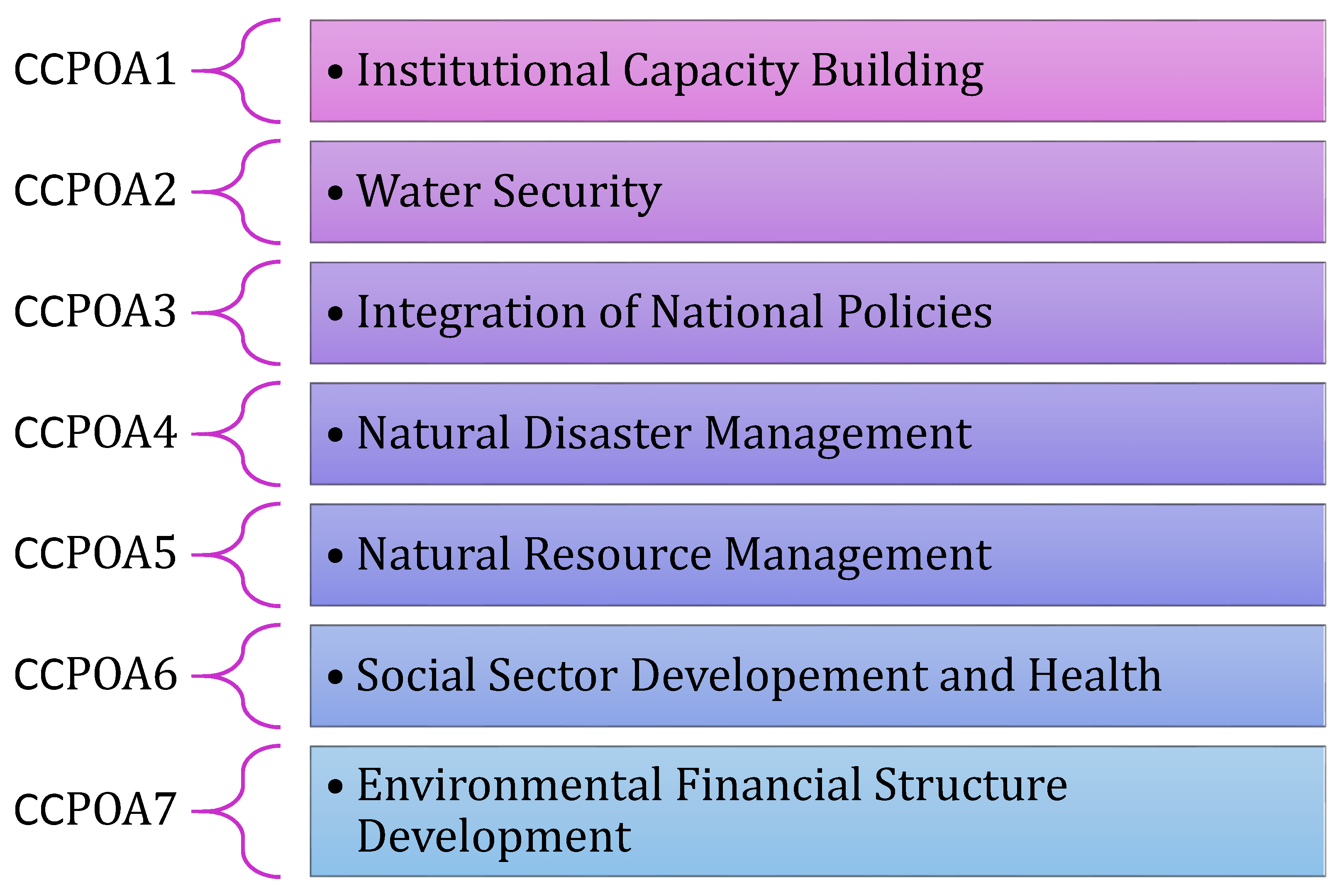
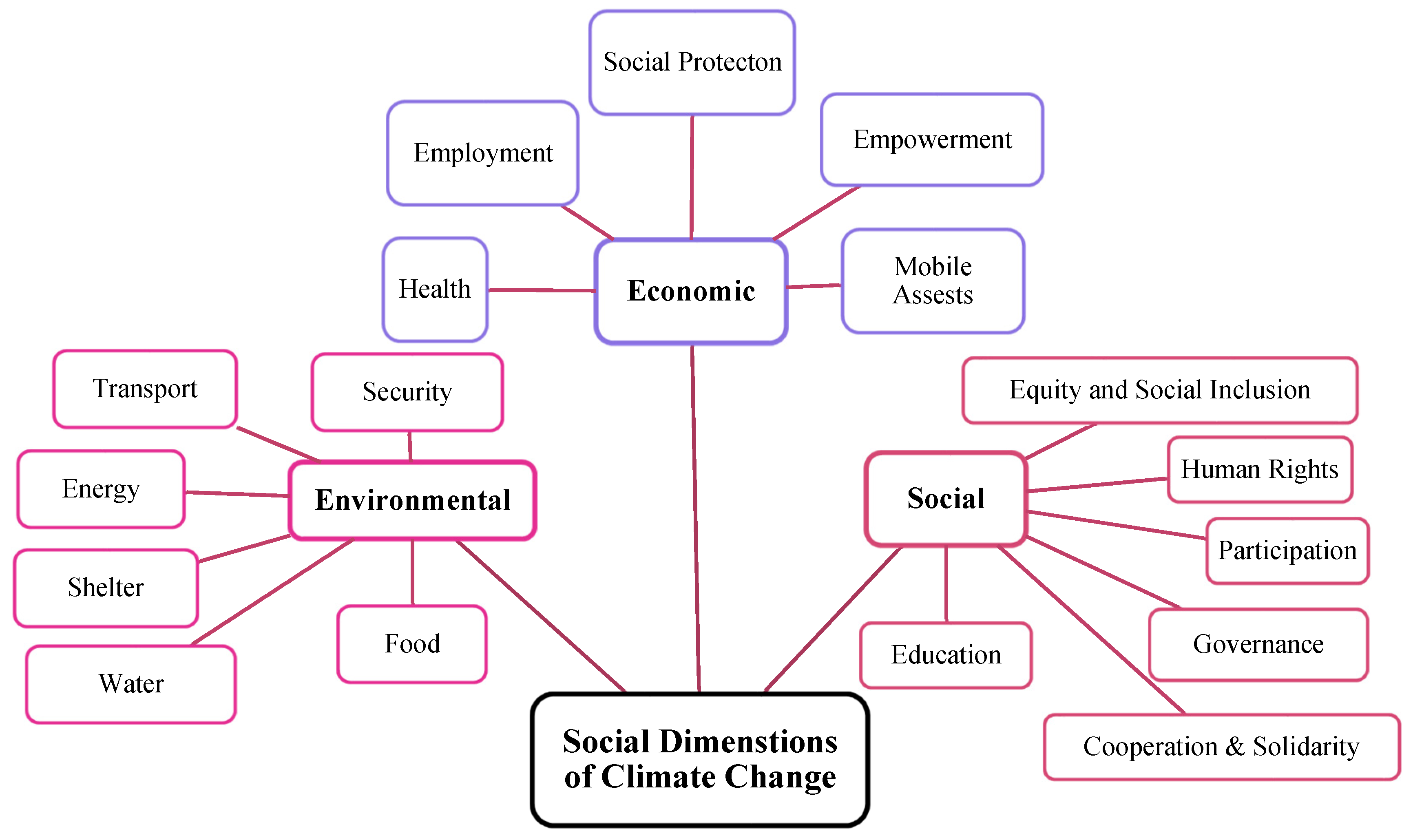
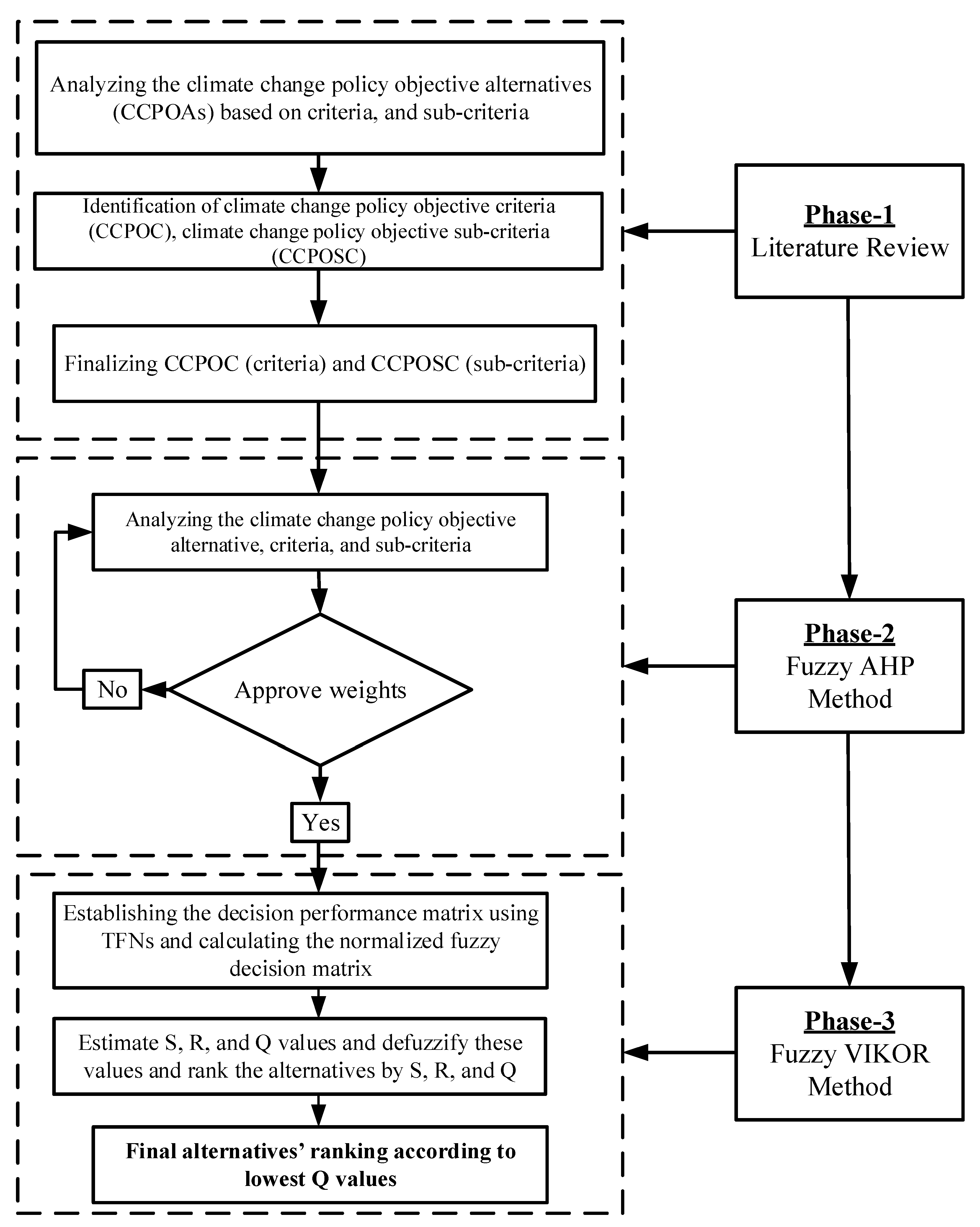
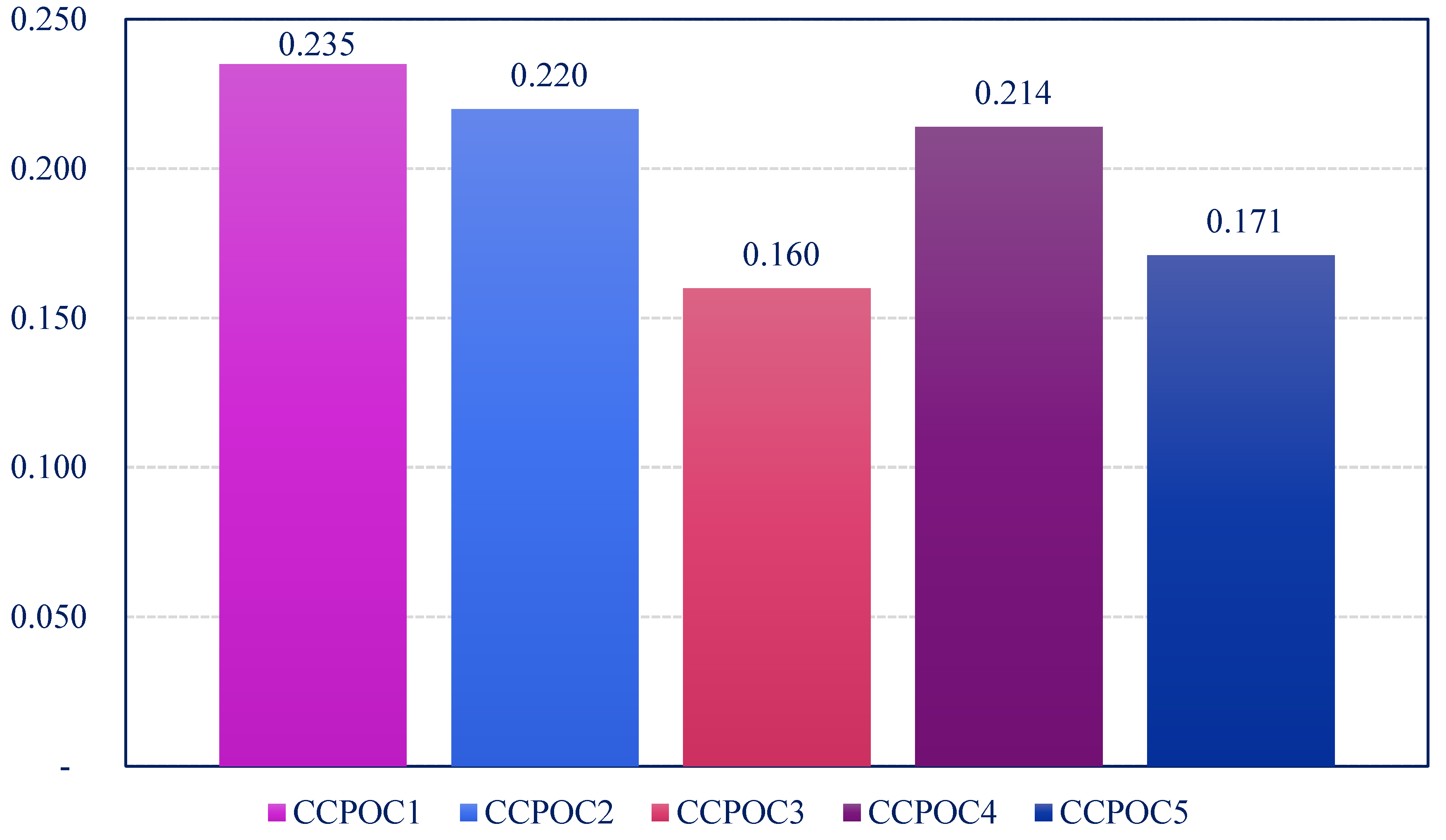
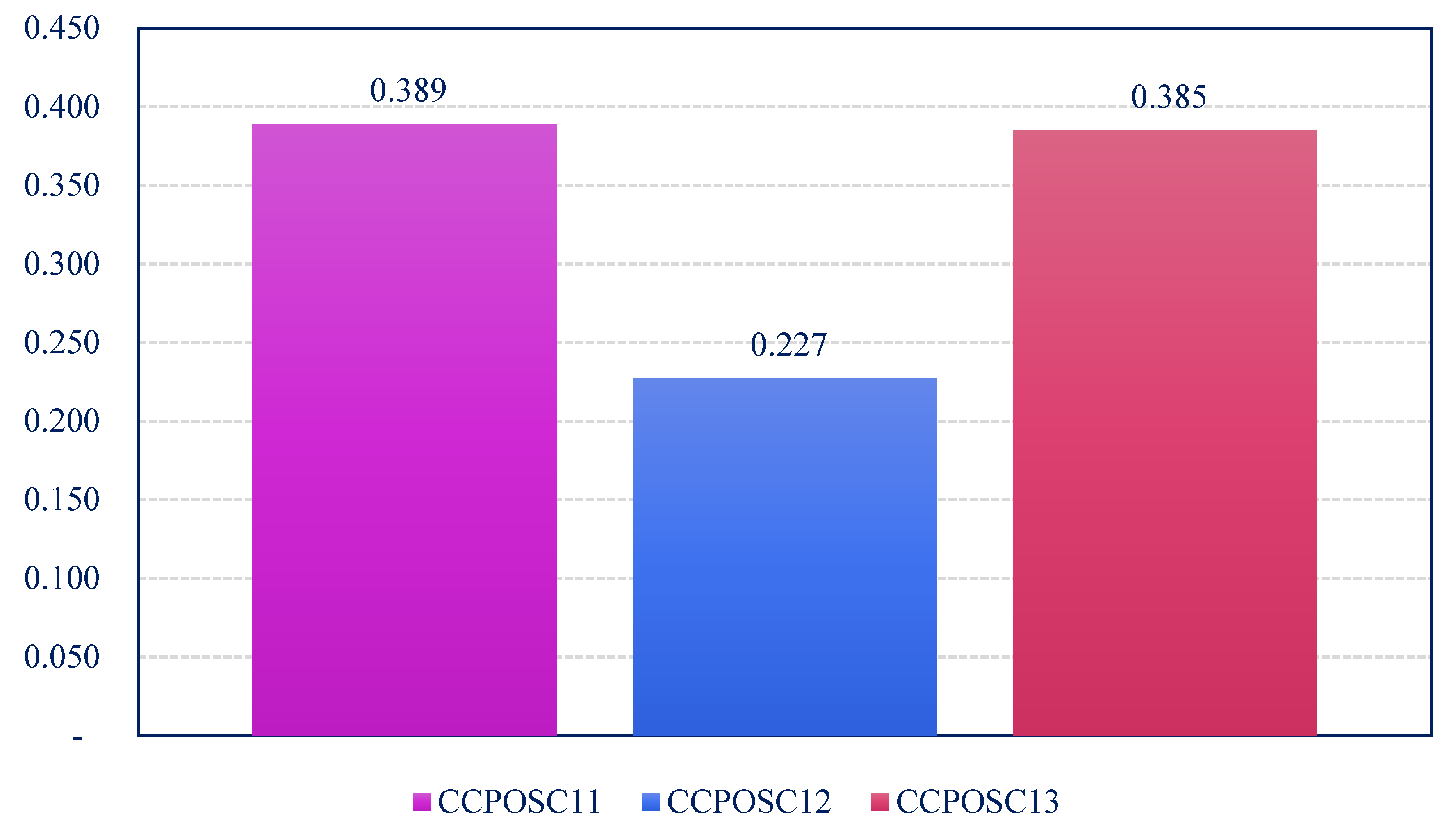
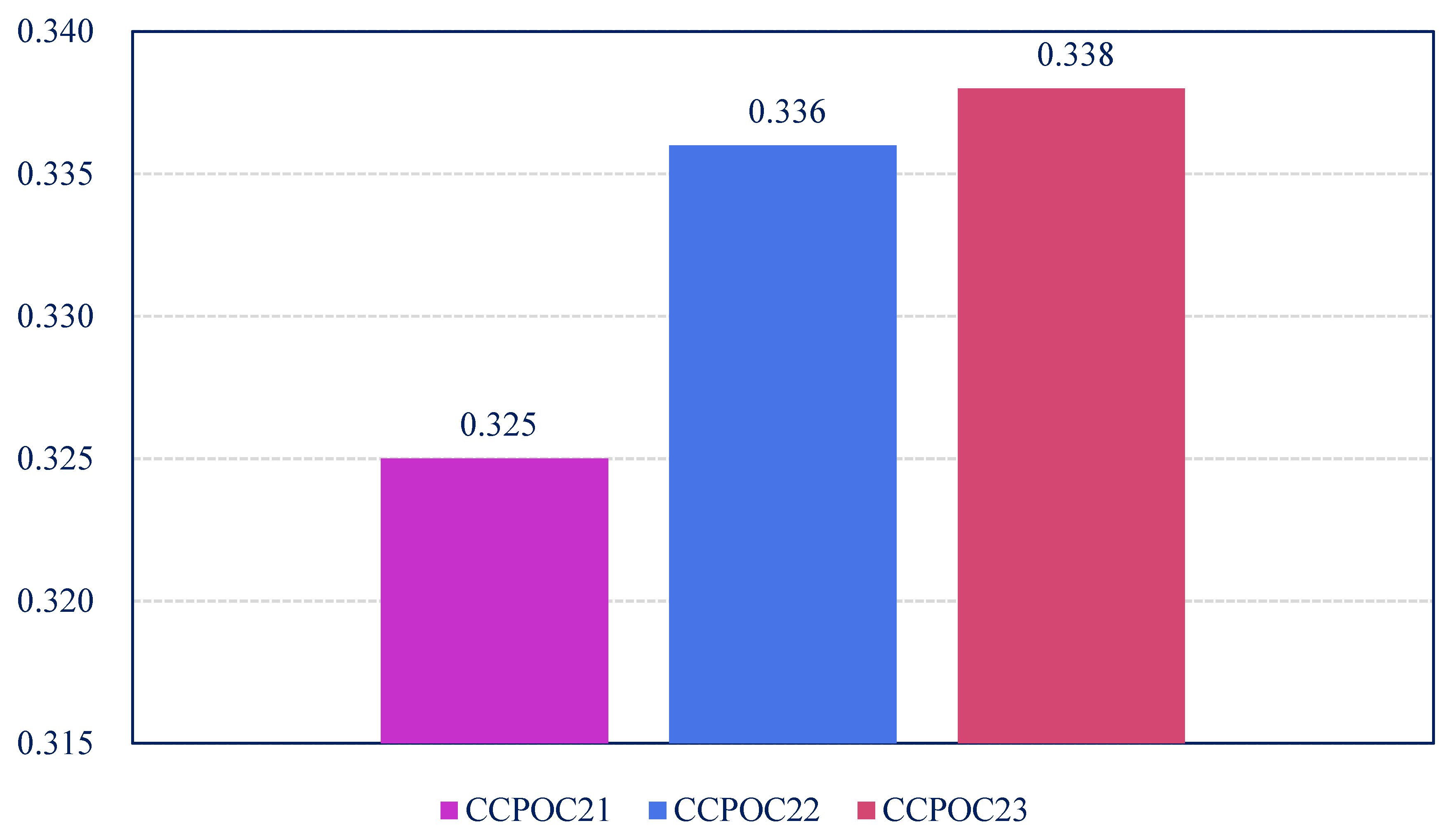
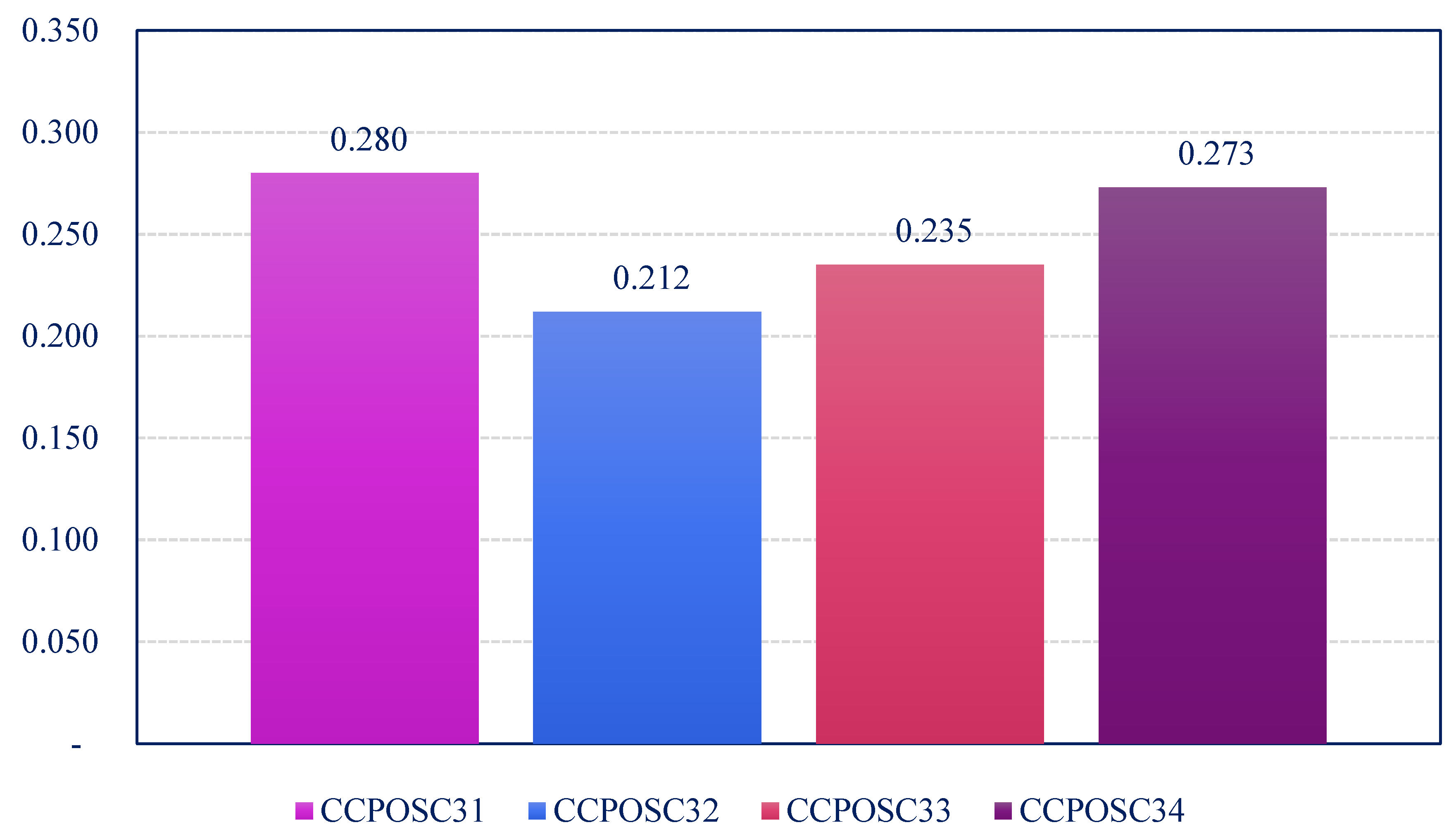

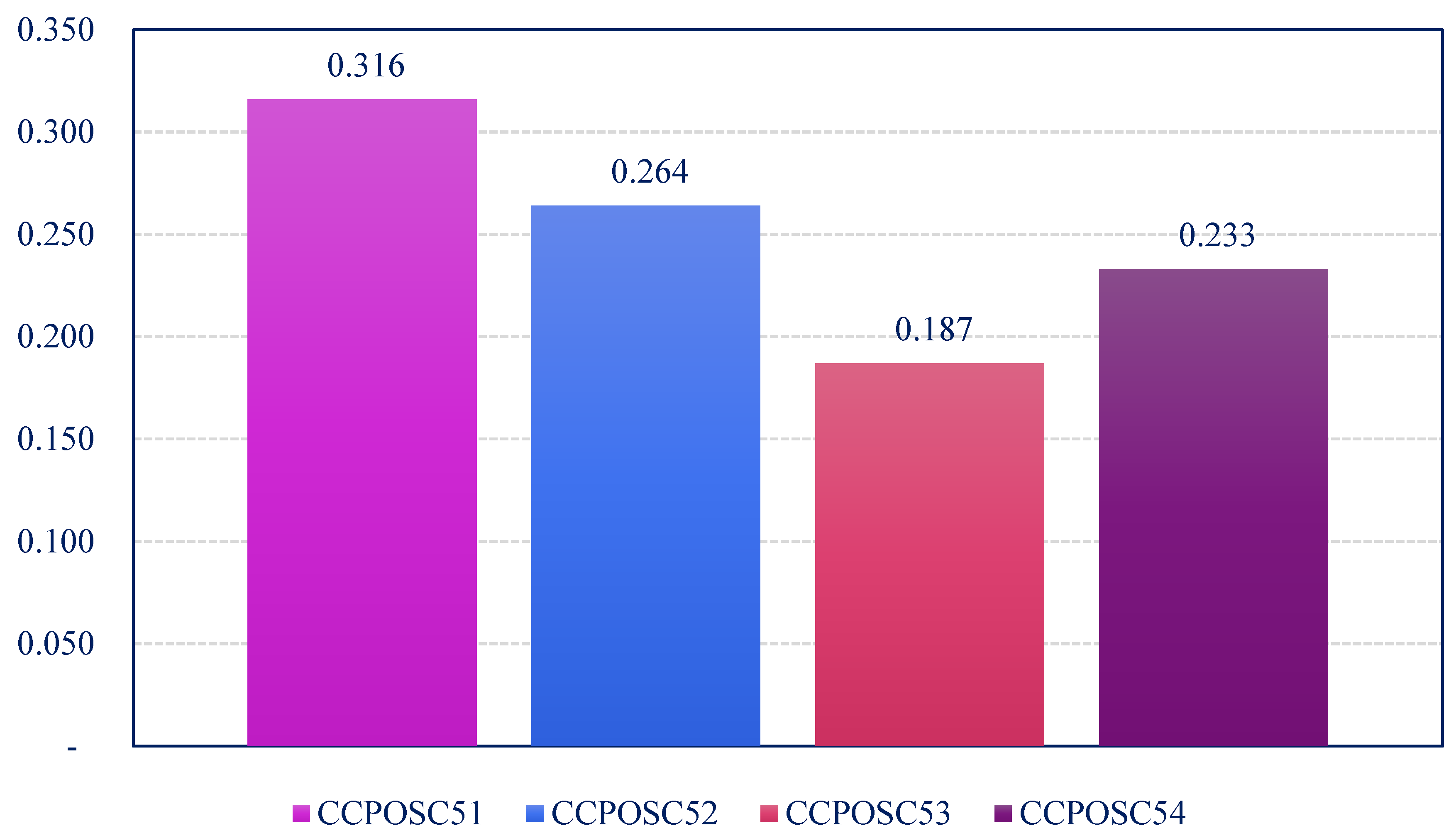
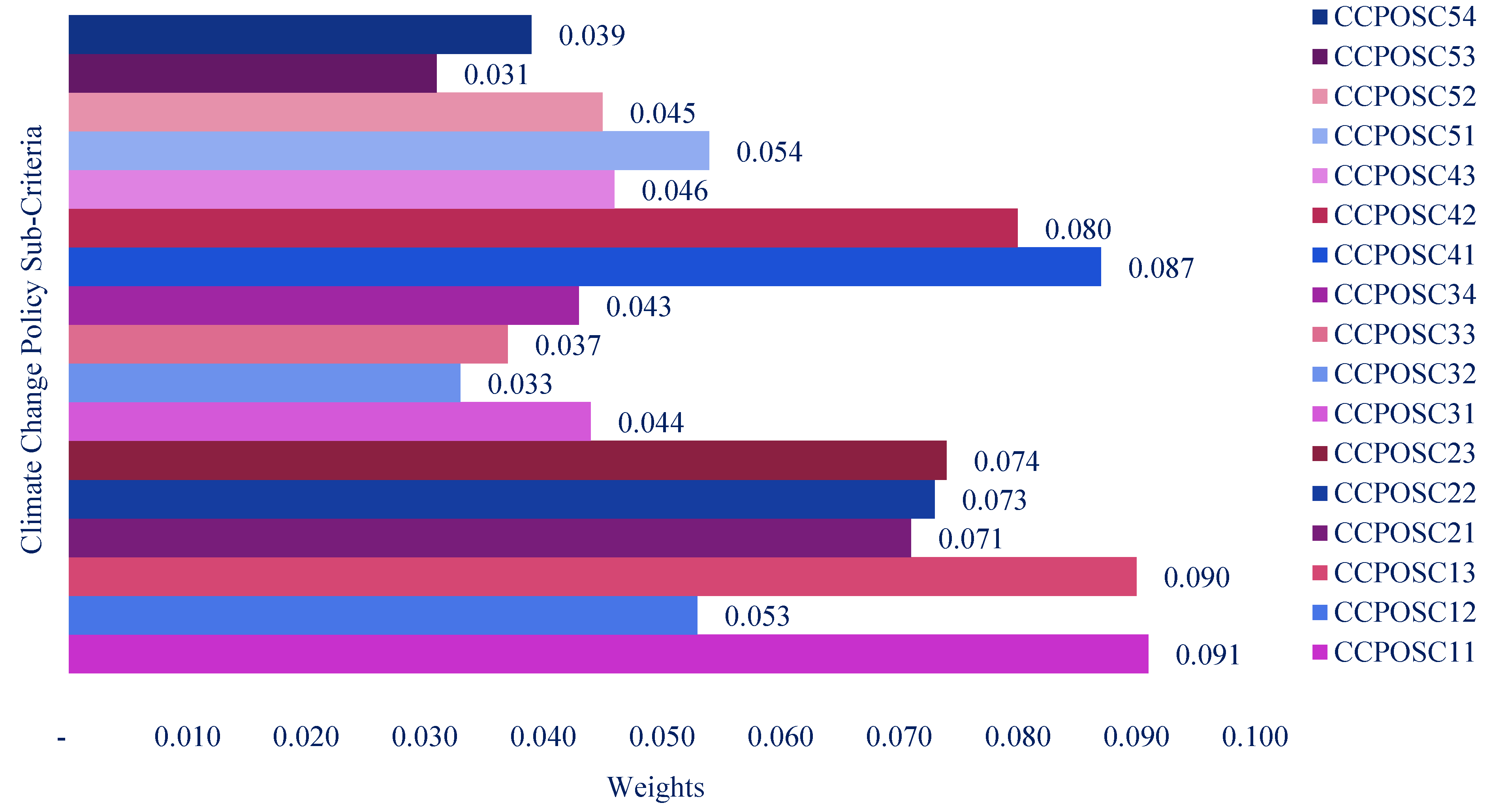
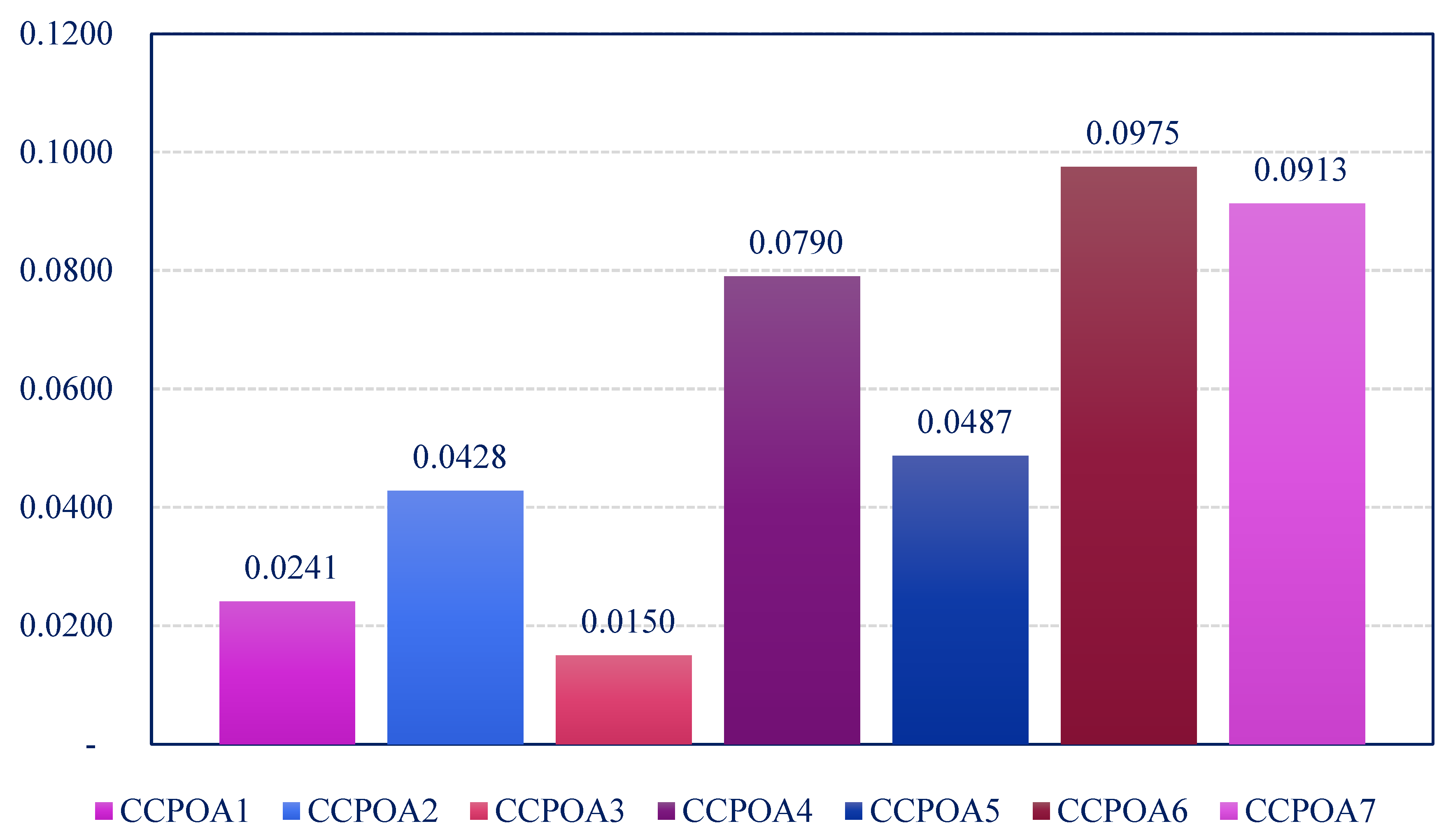
| Criteria | Sub-Criteria | Description |
|---|---|---|
| Energy (CCPOC1) | Energy Production (CCPOSC11) | Energy production is one of the foremost reasons for anthropogenic CO2 emissions [15,16,17] Mitigation and adaptation measures are required on an urgent basis for environmental resilience. |
| Transmission and Distribution (CCPOSC12) | Upgradation and improvement of transmission lines and distribution systems could help reduce line losses and increase the efficient use of produced energy [18]. | |
| Fiscal Reforms in the Energy Sector (CCPOSC13) | Fiscal reforms in energy sectors are direly needed to tackle circular debt [33]. Energy investment policy needs to be focussed on investment in green energy. A shift of energy mix from non-renewable to renewable energy sources to ensure environmental sustainability. | |
| Transport (CCPOC2) | Road Infrastructure (CCPOSC21) | Road infrastructure is vital for the movement of people and goods and services. Moreover, it also integrates the country, facilities economic activity, labor mobility, help generate employment opportunities, and poverty alleviation. Transport infrastructure is the center of political and scientific debate on sustainability due to its negative externalities both on the environment and quality of life [20]. Improving the road infrastructure considering environmental and climate is imperative [21]. |
| General Transport (CCPOSC22) | The number of transport vehicles during the last decades has increased a lot. This sector is one of the highly energy-consuming sectors and GHG emission contributors [17,28,34]. It is one of the main areas that need mitigation and adaptation. | |
| Railways (CCPOSC23) | Despite a potential single major transport mode of transport contributing to economic growth and national integration, the Pakistan railway has not been able to efficiently to provide sustainable transport facilities [22]. A comprehensive railway rehabilitation plan is warranted to provide a comparatively environmentally friendly transport facility. It could be the first step towards green transport system in Pakistan. | |
| Urban & Town Planning (CCPOC3) | Population and Urbanization (CCPOSC31) | Having rampant population growth and unmanaged urban sprawl in Pakistan, integrated population control and urban planning is required for successful mitigation and adaptation measures to climate change [22]. |
| Integrate Mass-Transit System (CCPOSC32) | Urban transport management is a critical and challenging issue [23,24] The development of integrated urban mass-transit systems in the big cities indispensable to reduce the number of vehicles and provide sustainable transport facilities [22]. Also, urban transport needed to be moved to renewable energy and fuels for a sustainable urban environment. | |
| Solid Waste Management (CCPOSC33) | Solid Waste Management (SWM) is one of the biggest challenging issues, especially in urban areas [35]. The development of the SWM system must be considered in the climate change policy. | |
| Water Management (CCPOSC34) | Water management in urban areas is not considering climate change [25]. Rampant urbanization has heightened the pollution of groundwater in urban areas. There is a dire need to incorporate the climate change perspectives in water management such as the provision of clean drinking water and disposal and recycling of drainage and wastewater. | |
| Industry (CCPOC4) | Air Pollution (CCPOSC41) | The industrial and manufacturing sector is a major source of anthropogenic GHG emissions [28]. Industrial and manufacturing plants need to be shifted to renewable energy to mitigate emissions for the industrial sector. |
| Water Pollution (CCPOSC42) | Industrial plants cause water pollution. Water treatment plants need to be constructed to ensure water quality [26,27]. Climate change policy must imperatively consider the water pollution sourced from the industry. | |
| Land Pollution/Brownfield (CCPOSC43) | Land pollution and brownfields are a serious issue in Pakistan [29] but have not attracted enough attention from the government and policymakers. | |
| Agriculture (CCPOC5) | Crops (CCPOSC51) | There is extensive use of fossil fuels, pesticides, herbicides, fertilizer, and other chemicals in the crop growing process [31] in economies including Pakistan. Environmentally friendly crop growing techniques and practices could be prolific if dovetailed in climate change and agricultural policy. |
| Irrigation System and practices (CCPOSC52) | The agriculture sector is one of the largest water-using sectors in most of the regions in the world [36]. Pakistan is no exception to this. Irrigation system and water use practices in agriculture are characterized as inefficient [30]. Having Pakistan an agrarian economy, the irrigation management system and water use practices in the agriculture sector needs attention in climate change policy. | |
| Livestock (CCPOSC53) | The livestock sector also contributes to climate change. It has a large potential to reduce its GHG emissions [32]. This sector also needs attention in the climate change policy. | |
| Forestry (CCPOSC54) | Deforestation in the economy has its environmental consequences. Multiple initiatives such as the reduction of emissions from deforestations and forest degradation as a mitigation strategy in the forestry sector [32]. |
| Study | Purpose | MCDA Method |
|---|---|---|
| Papapostolou et al. [53] | Analysis of cross-border renewable energy cooperation strategies. | AHP, SWOT, Fuzzy TOPSIS |
| Salimi et al. [54] | Examination of the role of advertising types on water consumption behavior. | Fuzzy AHP, Fuzzy VIKOR |
| Dao et al. [55] | Assessment of environmental conflicts in the mining industry. | Fuzzy AHP, Fuzzy TOPSIS |
| Shumaiza et al. [56] | Application of MCDA approaches on the selection of waste treatment and site selection for the thermal power station. | Fuzzy VIKOR, Fuzzy TOPSIS |
| Solangi et al. [57] | Analysis of the solar power project site selection for renewable energy production. | AHP, Fuzzy VIKOR |
| Solangi et al. [16] | Evaluation of the strategies for sustainable energy planning. | SWOT-AHP, Fuzzy TOPSIS |
| Ahmed et al. [58] | Environmental implications of crop-stubble burning and its implications on climate change. | AHP, TOPSIS |
| Wang et al. [59] | Sustainable energy conservation technologies selection for agriculture residue. | Fuzzy AHP, VIKOR |
| Shah et al. [15] | Examination of barriers to the adoption of cleaner energy production technologies. | Modified Delphi, Fuzzy AHP |
| Busico et al. [60] | Modeling actual and future climate change accounting water resources attention role. | GIS, AHP |
| Xu et al. [61] | Analysis of economic viability and environmental efficiency of the hydrogen production process for decarbonization of energy systems. | Fuzzy AHP, Fuzzy TOPSIS |
| Suganthi [62] | Multi-expert and multi-criteria analysis of sectoral investment for sustainable development. | Fuzzy AHP, VIKOR, DEA |
| Udie et al. [63] | Vulnerability assessment of climate change impact on critical oil & gas unfractured. | AHP |
| Champalle et al. [64] | Prioritization of climate change adaptation. | MCDA, NCA |
| Kim and Chung [65] | Prioritizing climate change adaptation strategies. | VIKOR |
| Chung and Kim [66] | Prioritization of locations of treated wastewater use regarding climate change scenarios. | WSM, TOPSIS, Fuzzy TOPSIS, |
| Kim and Chung [67] | Assessing the vulnerability of water supply to climate change and variability in South Korea. | Fuzzy VIKOR |
| Kaya and Kahraman [68] | Renewable energy planning for alternative energy policies. | Fuzzy VIKOR, AHP |
| Alternative | Rank | |||
|---|---|---|---|---|
| Institutional Capacity Building (CCPOA1) | 0.1514 | 0.0278 | 0.0241 | 2nd |
| Water Security (CCPOA2) | 0.1517 | 0.0302 | 0.0428 | 3rd |
| Integration of National Policies (CCPOA3) | 0.1881 | 0.0247 | 0.0150 | 1st |
| Natural Disaster Management (CCPOA4) | 0.2231 | 0.0311 | 0.0790 | 5th |
| Natural Resource Management (CCPOA5) | 0.2293 | 0.0269 | 0.0487 | 4th |
| Social sector development and health (CCPOA6) | 0.2281 | 0.0333 | 0.0975 | 7th |
| Environmental financial structure development (CCPOA7) | 0.3164 | 0.0278 | 0.0913 | 6th |
© 2020 by the authors. Licensee MDPI, Basel, Switzerland. This article is an open access article distributed under the terms and conditions of the Creative Commons Attribution (CC BY) license (http://creativecommons.org/licenses/by/4.0/).
Share and Cite
Ahmed, W.; Tan, Q.; Shaikh, G.M.; Waqas, H.; Kanasro, N.A.; Ali, S.; Solangi, Y.A. Assessing and Prioritizing the Climate Change Policy Objectives for Sustainable Development in Pakistan. Symmetry 2020, 12, 1203. https://doi.org/10.3390/sym12081203
Ahmed W, Tan Q, Shaikh GM, Waqas H, Kanasro NA, Ali S, Solangi YA. Assessing and Prioritizing the Climate Change Policy Objectives for Sustainable Development in Pakistan. Symmetry. 2020; 12(8):1203. https://doi.org/10.3390/sym12081203
Chicago/Turabian StyleAhmed, Waqas, Qingmei Tan, Ghulam Muhammad Shaikh, Hamid Waqas, Nadeem Ahmed Kanasro, Sharafat Ali, and Yasir Ahmed Solangi. 2020. "Assessing and Prioritizing the Climate Change Policy Objectives for Sustainable Development in Pakistan" Symmetry 12, no. 8: 1203. https://doi.org/10.3390/sym12081203
APA StyleAhmed, W., Tan, Q., Shaikh, G. M., Waqas, H., Kanasro, N. A., Ali, S., & Solangi, Y. A. (2020). Assessing and Prioritizing the Climate Change Policy Objectives for Sustainable Development in Pakistan. Symmetry, 12(8), 1203. https://doi.org/10.3390/sym12081203








